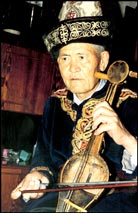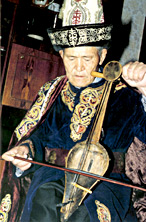Kiakchi
The old man's well-lined face crinkles with emotion as he draws the bow over the horse hair strings of his instrument, the kyl kiak. Carved from a single piece of wood, it resembles a big wooden soup ladle with two thick black strings. Its 'dipper' is covered with a soundboard made of camel hide. Except for a steel brace screwed into the instrument's back (broken, I'm told, in the 1930s), every part of the kyl kiak grew from the earth or an animal.
Eyes shut, brow furrowed, the old man's lips curl back over a gold-toothed grimace as a reflective circle of sound envelopes player and audience during "Eldik Koshok (Crying Song)." It depicts the sobbing of a Kyrgyz maiden married off to a rich man in China. Here, under gnarled fingers no more sure and strong, flows music stripped of virtuosity to the purest emotion.
 Toltoy Murataliev Kurenkeyevich |
It isn't music you can hear in concert halls, though it once was. This performance is staged in the small living room of the player's apartment in a non-descript Soviet-era cinder block building in a city of the like same, Bishkek, capital of the Kyrgyz Republic. Before submitting to the urbanizing Russian boot (first czarist, then Soviet), the Kyrgyz were nomads in their mountainous Central Asian land: fierce warriors by some accounts, gentle pastoralists by others. ("Before Russians," one Russkya smugly asserts, "they like Indians with feathers.") Music helped pass the long hours of herding, and the kyl kiak (like its kindred instruments, the Kazakh kobyz and the Mongol morin-huur) was designed to be played on horseback in the day as well as by the yurta's firelight in the evening. Like its Mongol cousin, the morin-huur, the kyl kiak sometimes has a horsehead carved proudly on the peghead; `kyl' means horse's tail. The horse's primacy in Central Asian nomadic cultures found its musical voice via these simple yet expressive bowed instruments.
The old man picks up the pace with "At Ketti (A Horse Took Off)." It starts at a leisurely trot and gradually builds to a gallop--a colt at play become music. "At Ketti" is a standard among kiak players; it was composed by the old man's grandfather, Muratali Kurenkeyev (1860-1949). That name is invoked with reverence by Kyrgyz traditional musicians: "When he played," says Nurak Abdirakmanov, the senior member of the Kyrgyz national folklore troupe, Kambarkan, "it was not like a man playing an instrument; it was like the cry of a wild animal." Few now living have heard that cry: Kurenkeyev died just over a half century ago, and his grandson says he made only one two-sided recording, a copy of which lies mothballed in an inaccessible state archive.
Toltoy Murataliev Kurenkeyevich bears both his grandfather's music and his name. After his father was killed in the Great Patriotic War (WWII), he joined his grandfather's household and there learned his music. He illustrates his legacy by playing "Ker Ozon, (The Wide Ravine)," another of his grandfather's tunes which, like "At Ketti," has become a standard among kiak players. On a living room shelf in a place of honor is a photograph of a beatific old man, Muratali Kurenkeyev. The instrument in the picture is the same one on which his grandson now plays. This kiak, he says, is a legacy far older than his grandfather's compositions--it is 300 years old. Who can dispute it? It is rougher and plainer than most kiaks now; no horsehead adorns the rudimentary peghead, and the tuning pegs are oblong wooden blocks. The camel hide soundboard is hard and brown with age and sags severely (it appears ready to collapse into the instrument's belly). If it is even half as old as claimed, then this kiak sang its wild cry for Kyrgyz horsemen long before Russian civilization confined it (and its last player) to a gray cinder-block dwelling in a neighborhood I'm told is rife with "hooligans and narcos." Not quite so long ago, it sang its proud horse songs far from its Kyrgyz homeland: Twice, the old man recalls proudly, he played it in concerts in Rome. And his legendary grandfather? Why, he played this very instrument in Moscow for Stalin! History as well as music flows from this kiak, its life experience analogous to that of the Kyrgyz people. It was handed down for generations to finally become the prized possession of this old man whose life is now more past than future.
Scrapbooks come out and the old man is suddenly young and robust in black & white. That photo? Moscow with a Kyrgyz folk troupe. Here, by the fountains, Rome. Not so long ago now, and in color, he's part of the Kyrgyz national folk music ensemble, Kambarkan. And there are several diploma-like awards with heroic Lenin heads and titles like `Distinguished Artist, USSR.' The Distinguished Artist dons an ornate robe and kalpak (Kyrgyz traditional hat) for photos. For posterity, too, he offers minute details about his instrument: The bow has precisely 120 horsehairs, he says. The right string is made up of exactly 64 horsehairs, and the left, 74. The hairs for kiaks must come from the tails of stallions or geldings; mare's urine renders hair useless for instruments. Then the old man plays, and again his weathered face is transformed by emotion as his fingers make the horsehair sing. Of his songs, the spry "At Ketti" is the exception--most are far slower and sadder. For this kiakchi (master kiak player), how can it be otherwise? He is the last of his line. Four months ago, his only son died. Now the old man and his music inhabit a house of women. Once, he says proudly, Baktybek Shatenov, star kiak player with the Kambarkan Ensemble, was his student. But students no longer come to learn his music and that of his legendary grandfather. (The old man isn't nearly as old as he looks. He is 61, but his appearance suggests he might be nearly two decades older. Perhaps, like much else here, he is ravaged by change and loss.)
When the old man dies, what will become of the kiak of Muratali Kurenkeyev, whose name is to Kyrgyz kiak players what Michael Coleman's name is to Irish fiddlers? "Someone told me I should sell this kiak for one million som," the old man boasts, "but I will never sell it."

Among the Kazakhs, the nearest kindred people to the Kyrgyz in Central Asia, there is a tradition that an instrument is passed down through the family. If a master musician dies and there is no one in his family to play it, his instrument is then hung on a wall, where it awaits a future boy who will take it up. Instruments, after all, are patient--their music may lie dormant a generation or more. Perhaps, in this kiak's time, this has happened to it. But today's young Kyrgyz have little patience for the pastoral wail of the kiak: the synthoid sproing of disco (both Western originals and Russified knockoffs) jackhammers from cafes, cabs, and sidewalk bazaars everywhere in Bishkek. In such a place with such a soundtrack, what possible incentive is there for a boy to aspire to grow up to become a kiakchi?
"You have very good taste in music," the old man asserts on my second visit to his flat. After recording him, he admires my little Walkman DAT recorder and says, "Very nice! The Japanese came to record me, and gave me a very nice tape recorder, but I no longer have it." I pass on my cue to offer a replacement but pay him for recording him and thank him for his music and his time. Out on the street, his wife is effusive with thanks that an American has come to record her husband's music: First the Japanese, now an American! But to the young Kyrgyz who led me to Toltoy Murataliev Kurenkeyevich, he is no more than a pitiable joke, a sad old man with his memories of Rome, Soviet-era awards, and a curious relic of an instrument with which he makes odd crying sounds.
Click to hear 'Eldik Koshok (Crying Song)' performed by Toltoy Murataliev Kurenkeyevich - (opens in its own small window)
Or click on the direct link:
cryingSong.mp3
Mark A. Humphrey
Written on the Bishkek to Istanbul flight, July 5, 2000